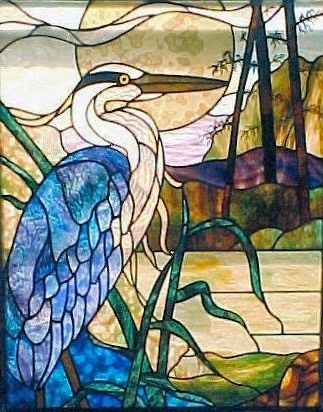Stained glass art is a deeply rewarding hobby for amateurs, and colorfully expressive medium for serious artists alike. There are many aspects to the craft that you should learn about and master if you are to be successful at it, including how to cut the glass, foiling heavily textured glass, grinding, soldering (flux application and filling gaps, burnishing, etc.), and finishing (application of patina). Other aspects of this unique art form are lamp photography, zinc framing, and, for the more ambitious and assured stained glass art practitioners, pricing your finished works.
Choices on cutting stained glass mean cutting large sheets, cutting curves with a tapping technique, or learning how to cut inside a deep curve. Grinding glass is fairly easy to learn, and artists need not become journeyman technicians on a grinder to be able to smooth out the edges. Foiling heavily textured glass entails taking a strip of quarter inch foil (approx.) and edging the glass with it, then taking a knife and cutting it flush with the edge. Foiling may prove to be a bit of a task, but cutting and trimming it down so the glass pieces fit smoothly will be well worth the extra effort.
In the soldering process, flux application prevents oxidation of the base and filler materials, and is a very brief process, whereby it is simply brushed on once. Flux also acts as a wetting agent, and reduces surface tension. Centering the glass is the next step, and means making space between all the glass pieces for the solder. Dropping the solder comes next, and involves touching a rope of solder to a soldering iron, allowing the substance to melt into the cracks between the glass. Filling the gaps and burnishing comes next, involving taking the hot iron and making finer touches to the solder-filled cracks. Beading the lead lines is a nice aesthetic flourish, and involves taking the hot iron again and making a raised bump of solder at intersections of the malleable strips. Patina application is the final step, and is quite easy. The liquid is merely poured on the finished glass piece and spread around, using protective latex gloves.
Stained glass art translates into finished products such as boxes, lamps, and other decorative objects, as well as entry to other mediums, such as photography. Panel lamps, Styrofoam mold lamps (Worden system), fiberglass mold lamps, or Odyssey system lamps ("no tacky wax method") are among the choices for lamp-making. Panel and mold set-ups allow you to make your own stained glass lamp designs. Photographing your lampshade for exhibition purposes allows you to put your new objet d'art on film, provided you use the right photographic accessories, such as slow film (100-200 ASA), a camera with 80A filter mounted on a tripod, several feet of black velvet to place the object on, and special incandescent light bulbs and clamps for lighting the lamp for starker, more vivid effect.
Stained Glass Art


Reviewed by Unknown
Published :
Rating : 4.5
Published :
Rating : 4.5









No comments:
Post a Comment